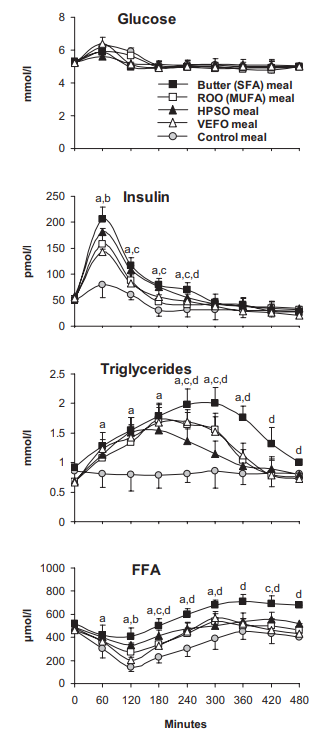When fat cells respond to insulin they take several actions in switching from fat burning mode to glucose burning and fat storing mode. These actions include:
- Turning off lipolysis – the process of releasing fats into the bloodstream as Free Fatty Acids which other cells can use energy
- Absorbing Glucose and beginning de no lipogenesis – the process of turning glucose into fat
- Turning off fat metabolism (oxidation) in favor of glucose metabolism
- Absorbing and storing fat from the diet.
This Spanish paper really shows the effect of a high fat meal on energy supply available to cells and how it changes according to whether the fat involved causes physiological insulin resistance (butter) or not – olive oil (ROO), high palmitic sunflower oil (HPSO) or a mixture of fish and vegetable oil (FEVO).

Study participants ate an 800 calorie meal at time zero with only about 160 calories of it coming from carbohydrate. The rest of the calories came from fat. The control meal (circles) was just 160 calories of carbohydrate and so I’ll mostly ignore it since it was so few calories compared to the other meals.
Free Fatty Acids (FFA) are released by fat cells into the bloodstream. Free Fatty Acids are used by many tissues and are a form of readily available energy. Triglycerides are fats that enter your bloodstream as your intestine absorbs fat after a meal and release it into your blood. They are a way to transport fat. Circulating triglycerides can be absorbed by fat or other cells for storage.
In response to the meal, in all cases the same thing happens: insulin and blood sugar rise, Free Fatty Acids drop and triglycerides begin to rise. The blood sugar rise is small and caused by the absorption of starch, which happens fairly quickly. Remember, there were only about 40g of carbohydrate. Within an hour blood glucose levels have peaked. Insulin also peaks at one hour in all cases and is only a little higher than the pre-meal level by 3 hours. The triglycerides take longer to be absorbed into the bloodstream and don’t peak until 2-5 hours after the meal, depending on the saturation level of the fat. Free Fatty Acids drop in response to all of the meals with a minimum at two hours after the meal and then rebound steadily.
If you look at the situation 180 minutes after the meal was eaten (three hours) the situation is this. In all groups blood glucose has returned to the pre-meal level. In the group who has eaten the high butter meal and is presumably the most insulin resistant, Free Fatty Acids have returned to the starting level. This is because insulin is less able to shut down lipolysis in this group and so the fat cells continue to release Free Fatty Acids. In the butter group, three hours after the meal, cells have access to the same amount of energy as pre-meal.
In every other group, at 180 minutes, glucose has returned to pre-meal levels but Free Fatty Acids have not, meaning there is less energy available to cells than before the meal was eaten. This will lead to hunger. In those groups, Free Fatty Acids don’t reach pre-meal levels until between four and five hours after the meal, after which their level starts to decline again.
But in the butter group alone, Free Fatty Acids climb to well above pre-meal level by 4 hours and remain elevated for the entire 8 hours of the experiment. The butter meal is providing extended energy availability to tissues of the body. The butter eaters will feel the least hunger from 3 to 8 hours post meal. Insulin resistance means that the fat cells didn’t reduce lipolysis as much and it rebounded faster.
Now let’s look at triglycerides. In all meals they climb for the first 2 hours. In the butter group they climb for the first 5 hours! But the rate of the increase was fastest for the butter, suggesting that it was the most quickly absorbed and therefore should have peaked first. In people who ate the most unsaturated fat (vegetable oil plus fish oil – black triangles), triglycerides are already dropping by hour three. In the groups of intermediate unsaturation, levels are dropping by hour four. Where are the triglycerides going? Remember each group ate the same amount of fat. They are being stored by the insulin sensitive fat cells as body fat in response to insulin.

The link to the Spanish paper does not work. Can you post a link to it?
Thanks! Fixed now.
More saturated fat, higher insulin. And more free fatty acids.
How to explain more lipolysis with higher insulin?
The reason for more lipolysis with more insulin is that the fat cells are insulin resistant. Insulin is present but its being ignored.
Thanks.
This answers one of my long standing questions about the Okinawa diet: “Why are all of the women skinny fat or just plain overweight?” Seafood is the main protein source and vegetable oils are used to cook the vegetable and meat dishes.